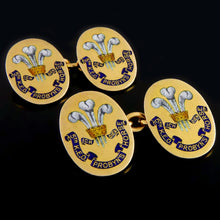5th King Edward’s Own Probyn’s Horse Cufflinks
Adding product to your cart
Circa 1925
Provenance: General Sir Douglas Baird, Probyn's Horse, late 12th Cavalry, Indian Army
Yellow gold oval panels all set with the Prince of Wales’s feathers and motto ‘Ich Dien’ over regimental title scroll in blue enamel ‘5th K.E.O. / Probyn’s / Horse’, reflecting the 1922 amalgamation at Meerut in 1921 of 11th King Edward's Own Lancers (Probyn's Horse) and 12th Cavalry to form Probyn's Horse (5th King Edward VII's Own Lancers). Cased.
Read more
General Sir Harry Beauchamp Douglas Baird, KCB, CMG, CIE DSO (1877-1963) was commissioned into the Indian Army in 1897, and appointed to the 12th Cavalry.
He was promoted Captain in 1906, and after graduating from the Staff College, Quetta, was selected as an Aide-de-Camp to the Chief of Staff, India, Lieutenant-General Sir Douglas Haig. It has been said that like fellow ADC John ‘Principal Boy’ Charteris, ‘Dolly’ Baird was chosen for his ability to get on with Haig. When Haig returned to Britain to be C-in-C in Aldershot Command in 1911 he arranged for his ADCs to accompany him in a move described at the time by regular staff as the ‘Hindu invasion’. On the outbreak of the First World War Baird went to France with Haig whose Aldershot Command comprised I Corps of the British Expeditionary Force. As such Baird would have been witness to his Chief’s much debated conduct at Landrecies, where, in his reactions to his corps' skirmish with German forces, Haig ‘led his staff into the street, revolvers drawn, promising to ‘sell our lives dearly’, while sending an exaggerated report to the C-in-C of the BEF causing panic.
Promoted Major in 1915, Baird served eight months on the staff of the Indian Cavalry Corps in France before becoming commanding officer of the 1/8th Battalion Argyll & Sutherland Highlanders in October of the same year. In June 1916 he was appointed General Staff Office 2 at 51st Highland Division, and established a divisional school of infantry for officers and NCOs to improve knowledge of tactics, discipline, communication, esprit de corps, sanitation, route marching, billeting, musketry, trench attacks, transport, map reading, and field engineering. The 14 day courses were considered effective and ran irrespective of whatever battle was raging at the time. In September 1916 Baird was briefly GSO2, Cavalry Corps, (France) before appointed commander of 75th Infantry Brigade from December 1916 to 1918 until February 1918.
After the War Baird returned to India to serve as GSO1 on the staff of 4th Indian Infantry Division.
He was Brigadier-General General Staff Baluchistan Force in 1919, and was briefly commander of the wartime raised 40th Cavalry Regiment and then commanding officer of the 28th Punjabis.

During 1920-23 Baird was Commander of the Zhob (Independent) Brigade Area (Baluchistan). In November 1920 he faced a mutiny in the Zhob militia and in response assembled a mobile column at Fort Sandeman, comprising a Sikh battalion, 7th Gurkhas, a section of mountain artillery and a troop of 20th Lancers - all served by a long train of camels. The operation consisted of establishing a series of outposts that were manned until they could be entrusted again to the militia. It was demanding work requiring vigilance and lasting five months. At the end of the period when marching back from Harnai to Fort Sandeman, the 7th Gurkha battalion was called upon to make one of the ‘hardest marches in its experience’, after the 20th Lancers were ambushed with the loss of Hotchkiss gun, horses and men.
Baird went on to become Colonel on the Staff at Army Headquarters, India in 1923 and Commandant of the Senior Officers' School, Belgaum in 1924. Baird went on to be Deputy Adjutant and Quartermaster-General in India in July 1929 and General Officer Commanding the Kohat District in December 1930. Then he became General Officer Commanding the Deccan District in 1932 and General Officer Commanding-in-Chief Eastern Command in April 1936 before retiring in April 1940. He was Hon. Aide-de-Camp General to the King George VI, 1938-40 and Colonel, 4th Battalion 5th Mahratta Light Infantry from 1935-1948.




